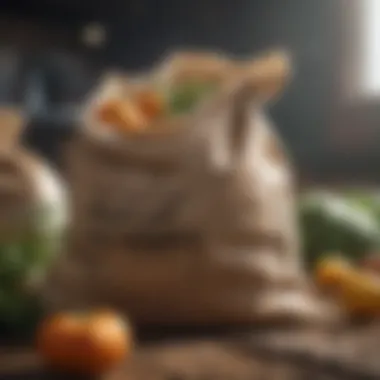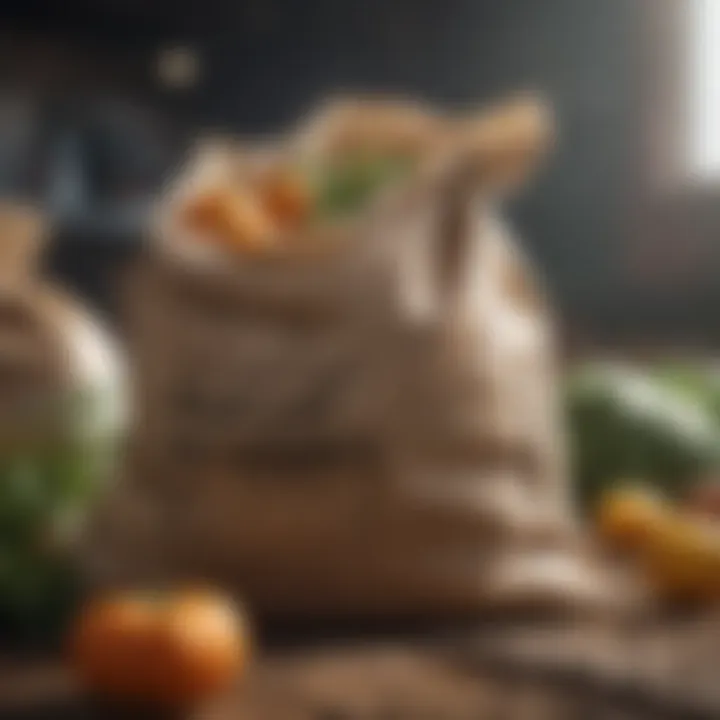Unveiling the Detrimental Impact of Plastic Grocery Sacks on the Environment


Overview of the Topic
Plastic grocery sacks have unfathomable repercussions on the environment, transcending mere convenience or functionality. These ubiquitous items embody a fundamental ecological dilemma that warrants urgent examination. As our society grapples with the escalating challenges of pollution and waste management, the detrimental impacts of plastic grocery sacks stand out starkly, demanding scrutiny and prompt action to alleviate their environmental burden.
Current Status and Challenges
At present, plastic grocery sacks have embedded themselves deeply into modern consumer culture, offering unparalleled convenience at a significant ecological cost. The pervasive use of these sacks has led to a pervasive environmental crisis, where landfills overflow with non-biodegradable material, water bodies become clogged with plastic waste, and wildlife face perils due to ingestion or entanglement. Recycling efforts have been impeded by the complexities of processing these bags, exacerbated by inadequate infrastructure and lack of consumer awareness, underscoring the urgent need for sustainable alternatives.
Sustainable Solutions
Addressing the challenge posed by plastic grocery sacks necessitates a multifaceted approach that combines innovation, policy intervention, and public engagement. Initiatives to promote reusable bags, biodegradable alternatives, or innovative recycling technologies have shown promise in mitigating the environmental impact of plastic sacks. Successful case studies in various regions highlight the efficacy of policies restricting single-use plastics, incentivizing eco-friendly practices, and fostering a circular economy where waste is minimized and resources are conserved.
Impact and Importance
The repercussions of plastic grocery sacks extend far beyond mere visual blight, permeating ecosystems, endangering wildlife, and compromising human health. The significance of this issue lies in its interconnectedness with broader environmental challenges, emphasizing the imperative of sustainable resource management and conservation efforts for the well-being of current and future generations. By comprehensively analyzing the impacts and importance of addressing plastic grocery sack usage, a compelling narrative emerges, urging us towards collective action and stewardship of our fragile planet.
Introduction
The issue of plastic grocery sacks and their impact on the environment is a pressing concern that demands attention and scrutiny. In the current global scenario, where environmental degradation poses a significant threat, delving into the specifics of plastic grocery sacks becomes imperative. This article aims to dissect and analyze the multifaceted implications of plastic bags, shedding light on their pervasive nature and detrimental effects on ecosystems. By exploring the nuances of this ubiquitous product, we aim to educate and raise awareness about the urgent need for sustainable alternatives and responsible consumer behavior.
Definition of Plastic Grocery Sacks
Plastic grocery sacks, also known as plastic carrier bags or plastic shopping bags, refer to the lightweight, single-use bags commonly distributed by retail outlets to carry purchased goods. These bags are typically made from polyethylene, a non-biodegradable material derived from petroleum. Their design prioritizes convenience and cost-efficiency, making them a popular choice for both retailers and consumers. However, their high consumption rate and improper disposal have raised significant environmental concerns, highlighting the need for a reevaluation of their usage and distribution practices.
Usage and Ubiquity
The usage of plastic grocery sacks has reached unprecedented levels, with billions of bags being produced and discarded annually worldwide. Their widespread availability and low cost have contributed to their ubiquity in various commercial sectors, from grocery stores to clothing outlets. Despite their convenience, the disposable nature of these bags means that they often end up in landfills, where they can take hundreds of years to decompose fully. Moreover, their lightweight design makes them prone to wind dispersion, leading to littering in urban and natural landscapes. Understanding the extent of their usage and the associated environmental implications is crucial for fostering sustainable consumption practices and minimizing ecological harm.
Environmental Context
In the broader environmental context, plastic grocery sacks play a significant role in contributing to plastic pollution and ecosystem degradation. These bags are a common sight in marine environments, where they pose a threat to marine life through ingestion and entanglement. Additionally, in terrestrial ecosystems, the improper disposal of plastic bags exacerbates landfill accumulation and contributes to habitat degradation. Their persistence in the environment not only disrupts natural ecosystems but also poses risks to human health through the release of toxic chemicals. By examining the environmental context surrounding plastic grocery sacks, we can gain insight into the intricate web of ecological challenges they perpetuate and the urgency of adopting eco-friendly solutions.
Impacts on Wildlife
Plastic grocery sacks have a profound impact on wildlife, especially concerning marine life and terrestrial ecosystems. Understanding these impacts is crucial for addressing the adversities caused by plastic pollution. By delving into the consequences on wildlife, we gain insight into how plastic grocery sacks disrupt natural habitats and endanger various species. The detrimental effects resonate beyond immediate pollution concerns, affecting the delicate balance of ecosystems.


Marine Life
Ocean Pollution
Ocean pollution, a direct result of plastic grocery sack usage, poses grave threats to marine ecosystems. The indiscriminate disposal of plastic bags leads to widespread contamination of oceans, endangering marine species and disrupting marine food chains. The persistence of plastic pollution in oceans underscores the urgency of combating this issue to safeguard marine biodiversity and ecosystem health. While convenient in the short term, the long-term implications of ocean pollution demand concerted efforts towards sustainable solutions.
Entanglement Risks
Entanglement risks associated with plastic grocery sacks highlight a lesser-known yet equally damaging consequence on marine life. Marine animals often become entangled in discarded plastic bags, leading to injuries, suffocation, and death. This aspect of plastic pollution underscores the immediate dangers faced by marine organisms due to human activities. By addressing entanglement risks, we not only protect marine species but also preserve the integrity of marine ecosystems.
Terrestrial Ecosystems
Landfill Issues
The impact of plastic grocery sacks on terrestrial ecosystems is evident in the escalating landfill issues worldwide. Improper disposal of plastic bags contributes significantly to landfill overburden, diminishing land productivity, and releasing harmful chemicals into the soil. Landfill issues stemming from plastic pollution call for efficient waste management strategies and sustainable alternatives to mitigate environmental degradation and safeguard terrestrial biodiversity.
Habitat Degradation
Plastic grocery sacks play a pivotal role in habitat degradation, disrupting natural environments and endangering terrestrial species. The degradation of habitats due to plastic pollution results in loss of biodiversity, habitat fragmentation, and ecological imbalances. Addressing habitat degradation caused by plastic bags necessitates proactive measures to reduce plastic usage, promote recycling, and enhance conservation efforts. By combatting habitat degradation, we can preserve essential ecosystems and support the survival of countless species in terrestrial environments.
Human Health Concerns
Plastic grocery sacks pose significant risks to human health, underscoring the critical importance of understanding and addressing this issue. The prevalence of harmful chemicals in plastic bags, such as phthalates and bisphenol A, raises concerns about chemical exposure to individuals who come into contact with these products. These toxic substances can leach into food items stored in plastic bags, potentially leading to adverse health effects when consumed. Additionally, the production and disposal of plastic bags contribute to air and water pollution, further exacerbating the health risks faced by communities residing near manufacturing or landfill sites. Recognizing these health implications is essential in advocating for sustainable alternatives to plastic grocery sacks to safeguard human well-being.
Chemical Exposure
Chemical exposure from plastic grocery sacks stems from the presence of endocrine-disrupting compounds like phthalates and bisphenol A, used in the manufacturing of these bags. When plastic bags interact with food or liquids, these chemicals can migrate from the bag to the contents, especially under conditions of heat or prolonged use. Once consumed, these chemicals may disrupt hormone balance, leading to various health issues ranging from reproductive disorders to developmental abnormalities. Moreover, industrial processes involved in plastic bag production release volatile organic compounds into the atmosphere, contributing to air pollution and subsequently affecting public health. Mitigating chemical exposure necessitates a shift towards alternatives that do not pose similar risks, promoting a healthier environment for all.
Microplastics Ingestion
Microplastics, resulting from the fragmentation of larger plastic items like grocery sacks, present a concerning pathway for human ingestion. When plastic bags degrade in the environment, they break down into smaller particles that can contaminate soil and water sources. Subsequently, these microplastics can enter the food chain, accumulating in seafood and other consumables. Upon ingestion, microplastics may release hazardous chemicals into the body and cause physical harm, ranging from internal damage to potential toxicity. To address the issue of microplastic ingestion, systematic changes in consumer behavior and industry practices are imperative, emphasizing the value of reusable and sustainable packaging solutions to combat the pervasive threat posed by plastic pollution.
Challenges of Recycling
Plastic grocery bags present a significant challenge in the realm of recycling, warranting a detailed examination of their impact on the environment. The necessity of addressing the challenges of recycling plastic bags stems from their pervasive presence in modern society, resulting in detrimental consequences for ecosystems and human health. Understanding these challenges is crucial for implementing effective solutions and promoting sustainable practices in waste management.
To delve deeper into the challenges of recycling plastic grocery sacks, it is essential to consider the complexities associated with their composition. Plastic bags are primarily made from polyethylene, a material known for its resistance to degradation. This characteristic poses a considerable obstacle to recycling efforts, as traditional recycling processes struggle to efficiently break down and reuse polyethylene-based products. As a result, plastic bags often end up in landfills or incineration facilities, contributing to environmental pollution and resource depletion.


Moreover, the lightweight and flexible nature of plastic grocery bags exacerbates recycling challenges by impeding sorting and processing procedures. Their tendency to clog recycling equipment not only hampers the efficiency of recycling facilities but also increases operational costs. Contamination risks further complicate the recycling of plastic bags, necessitating meticulous separation from other recyclable materials to ensure the quality and integrity of the recycling stream.
Addressing the challenges of recycling plastic grocery sacks requires a multi-faceted approach that encompasses technological innovations, policy interventions, and consumer education. By raising awareness about the implications of improper disposal and promoting sustainable alternatives, communities can minimize the adverse effects of plastic bag pollution and foster a culture of environmental responsibility.
Limited Recyclability
Plastic grocery sacks pose a stark dilemma in terms of recyclability, reflecting a pressing issue in contemporary waste management practices. The limited recyclability of these bags stems from their composition, which consists of non-biodegradable materials that resist traditional recycling processes. Unlike recyclable plastics with clear resin codes, plastic bags lack standardized labeling, making it challenging for consumers to distinguish between recyclable and non-recyclable plastics.
Furthermore, the thin and malleable nature of plastic grocery sacks complicates the recycling process, as they are prone to getting stuck in machinery and causing disruptions in recycling operations. These inherent characteristics render plastic bags less desirable for recycling facilities, leading to their exclusion from many recycling programs. The fragmented nature of recycling infrastructures across different regions also contributes to the limited recyclability of plastic bags, as not all facilities possess the capacity or technology to effectively recycle these items.
As a result, a significant portion of plastic grocery sacks ends up in landfills or incinerators, where they persist for extended periods without undergoing proper decomposition. This accumulation of non-recyclable plastic waste exacerbates environmental pollution and resource depletion, underscoring the importance of finding alternative solutions to address the limited recyclability of plastic bags.
Contamination Issues
Contamination poses a pervasive challenge in the recycling of plastic grocery sacks, accentuating the complexities associated with managing plastic waste. The issue of contamination arises from the co-mingling of plastic bags with other recyclable materials, leading to a diminished quality of the recycling stream and reducing the effectiveness of recycling processes. Contaminated materials not only compromise the recyclability of plastic bags but also jeopardize the integrity of entire batches of recyclables, necessitating rigorous sorting and decontamination procedures.
Common contaminants found in plastic bag recycling include food residues, liquids, and incompatible materials that impede the recycling process and devalue the recycled end products. The presence of contaminants not only undermines the sustainability of recycling initiatives but also poses health and safety risks to recycling facility workers. Addressing contamination issues requires increased vigilance in waste management practices, emphasizing proper disposal techniques and educating consumers about the significance of clean recycling streams.
By mitigating contamination risks and enhancing recycling infrastructures, communities can bolster the efficiency and effectiveness of plastic bag recycling efforts, paving the way for a more sustainable approach to waste management.
Sustainable Alternatives
Plastic grocery sacks have undeniably wreaked havoc on the environment, propelling the urgent need for sustainable alternatives to mitigate their adverse effects. This section delves into the pivotal role of sustainable alternatives in combating the environmental repercussions of plastic bags. By examining specific elements such as biodegradable options, reusable bags, and government policy initiatives, a comprehensive understanding of the viable solutions to this pressing issue unfolds.
Biodegradable Options
Biodegradable options stand out as a promising solution amidst the plastic bag crisis due to their eco-friendly nature. These alternatives have the unique ability to decompose naturally, significantly reducing the pollution and harm caused by traditional plastic bags. By exploring the benefits of biodegradable options, including minimal environmental impact and reduced landfill accumulation, it becomes evident that transitioning towards these alternatives can substantially alleviate the burden on ecosystems.
Reusable Bags
The significance of reusable bags as a sustainable alternative to plastic grocery sacks cannot be overstated. With a focus on longevity and durability, reusable bags offer a practical and eco-conscious solution to the single-use plastic dilemma. Delving into the benefits of reusable bags, such as waste reduction, cost-effectiveness, and enhanced convenience, underscores the importance of incorporating these eco-friendly alternatives into daily routines to diminish environmental harm.
Government Policy Initiatives
Government policy initiatives play a crucial role in encouraging the widespread adoption of sustainable alternatives to plastic grocery sacks. By implementing regulations, incentives, and support mechanisms, governments can drive meaningful change in consumer behavior and industry practices. This section examines the impact of government interventions in promoting sustainable alternatives, highlighting the importance of cohesive policies to foster a more sustainable and eco-friendly future.


Consumer Behavior Shifts
Awareness Campaigns
Conducting awareness campaigns is a strategic approach to mobilizing public opinion and disseminating critical information regarding the detrimental effects of plastic grocery sacks on the environment. These campaigns aim to instill a sense of responsibility and awareness among consumers, highlighting the urgency of transitioning towards eco-friendly alternatives. By leveraging various media platforms and community engagement activities, awareness campaigns can reach a broad audience and inspire action towards reducing plastic bag usage. Emphasizing the long-term consequences of single-use plastics and advocating for sustainable practices are central themes within such campaigns.
Education and Advocacy
Education and advocacy efforts are fundamental in fostering a collective understanding of the environmental implications associated with plastic grocery sacks. Through comprehensive educational programs in schools, universities, and communities, individuals can gain insights into the broader mechanisms of waste management, recycling protocols, and sustainable consumer behavior. Advocacy initiatives seek to influence policy changes, promote eco-friendly legislation, and amplify public voices in support of eco-conscious policies. By engaging in continuous education and advocacy, stakeholders can propel the momentum towards a greener, more environmentally conscious society.
Global Perspectives
Plastic grocery sacks have transformed from a convenience item to a global environmental concern. The topic of Global Perspectives in this article elucidates the interconnectedness of environmental issues and the imperative for international collaboration. By delving into the global outlook on plastic waste management, we uncover the multifaceted challenges and opportunities that transcend borders. Understanding the gravity of plastic pollution on a worldwide scale is paramount in formulating effective strategies for sustainability. Emphasizing the interconnected nature of ecosystems reminds us of the shared responsibility to mitigate environmental degradation.
International Regulations
International regulations play a pivotal role in addressing the proliferation of plastic grocery sacks and their detrimental impact. The formulation and enforcement of international standards can establish a framework for environmental governance, guiding nations towards cohesive efforts in waste management. Through international agreements and protocols, such as the Basel Convention or the Stockholm Convention, countries strive to harmonize policies to combat plastic pollution at a global level. Compliance with these regulations ensures a unified approach to mitigating the adverse effects of plastic waste, safeguarding ecosystems and human health worldwide.
Collaborative Efforts
Collaborative efforts are essential in tackling the pervasive issue of plastic grocery sacks and their environmental ramifications. Partnerships between governments, non-governmental organizations, industry stakeholders, and local communities are key to fostering innovation and sustainability. By working together on research initiatives, community outreach programs, and policy advocacy, diverse entities can leverage their strengths to drive meaningful change. Collaborations pave the way for knowledge sharing, resource mobilization, and the implementation of best practices in waste reduction and recycling. Ensuring inclusive participation and shared responsibility are fundamental in achieving long-term solutions for a cleaner and healthier environment.
Innovations in Packaging
In the world of packaging, constant evolution is imperative to mitigate environmental harm caused primarily by plastics. The section on Innovations in Packaging within this article meticulously dissects the critical aspect of implementing novel solutions to address the ecological challenges posed by traditional packaging methods. By shedding light on this topic, readers are presented with a roadmap towards sustainable packaging practices. The significance of embracing innovative packaging approaches lies in their potential to significantly reduce waste generation and carbon footprint. Not only do these advancements contribute to minimizing environmental pollution, but they also promote a shift towards a more sustainable future.
Amidst the discussion on Innovations in Packaging, attention is drawn to several pivotal benefits associated with embracing cutting-edge packaging technologies. These benefits include enhanced product protection, extended shelf life, reduced use of harmful materials, and improved recyclability. Moreover, innovations in packaging facilitate the optimization of resources and enable efficient waste management processes. By delving deep into the realm of sustainable packaging solutions, this article aims to inspire a conscious shift in consumer and industry behavior towards eco-friendliness. As the discourse unfolds, readers gain valuable insights into the multifaceted advantages that innovative packaging strategies bring to the table.
Technology Advancements
Within the broader spectrum of Innovations in Packaging, the section dedicated to Technology Advancements delves into the cutting-edge technological interventions revolutionizing the packaging industry. These advancements encompass a wide array of breakthroughs ranging from material innovations to manufacturing processes. By exploring the intricate details of technological upgrades in packaging, this section underscores the transformative impact of tech-driven solutions in reducing environmental degradation.
The narrative surrounding Technology Advancements delineates how groundbreaking technologies such as biodegradable packaging materials, smart packaging solutions, and advanced recycling technologies are reshaping the packaging landscape. By harnessing the power of technology, companies can now design packaging that ensures product safety while simultaneously minimizing environmental harm. Through a comprehensive analysis of these technological breakthroughs, this article aims to enlighten readers on the pivotal role that innovation plays in fostering sustainability within the packaging ecosystem.
Circular Economy Models
Complementing the discourse on Innovations in Packaging and Technology Advancements, the section on Circular Economy Models highlights the transformative potential of circular economic principles in redefining packaging production and consumption dynamics. Conventional packaging practices often follow a linear 'take-make-dispose' model that results in resource depletion and waste accumulation. However, by embracing circular economy models, the packaging industry can transition towards a regenerative approach that prioritizes resource efficiency and waste reduction.
The exploration of Circular Economy Models within this article elucidates how principles such as product reuse, material recycling, and extended producer responsibility can foster a closed-loop system that minimizes environmental impact. By transitioning towards circular economy models, businesses can not only mitigate the adverse effects of packaging on the environment but also create new opportunities for innovation and economic growth. Through a detailed investigation of these models, this section aims to advocate for a systemic shift towards sustainable packaging practices that benefit both the planet and future generations.
Conclusion
Plastic grocery sacks pose a significant threat to the environment, making it imperative to address the issue at hand. The overarching discussion serves as a wake-up call, emphasizing the critical need for immediate action in shifting away from plastic usage. This article has meticulously examined the multifaceted impacts of plastic bags on ecosystems and human health, highlighting the interconnectedness of environmental degradation. By delving into the detrimental effects on wildlife, including marine life and terrestrial ecosystems, a clear picture emerges of the havoc wreaked by plastic grocery sacks. Moreover, exploring the challenges associated with recycling these sacks sheds light on the complexities of mitigating their adverse effects. Presenting sustainable alternatives, such as biodegradable options and reusable bags, underscores the necessity for conscious consumer behavior shifts and government policy initiatives. The global perspective emphasizes the essential role of international regulations and collaborative efforts in combating plastic pollution. Innovations in packaging, such as technological advancements and circular economy models, offer hope for a future where sustainable practices are the norm. In this comprehensive examination, the urgent call for embracing eco-friendly measures becomes undeniable.



